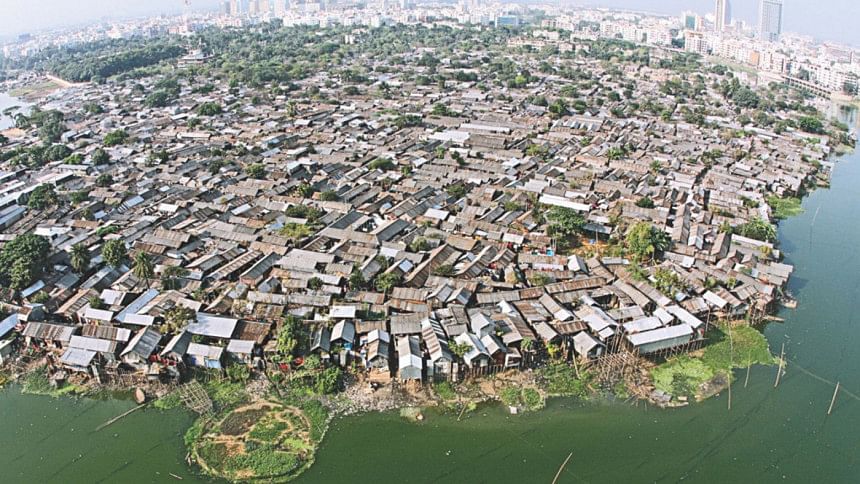Rapid urbanisation and a rise in infectious diseases

Income growth leads to increased urbanisation, which due to higher concentration of the population in smaller geographical areas can cause higher rates of infectious diseases. Bangladesh is no exception to this phenomena. Urbanisation means higher concentration and connectedness of people which helps infections spread faster. About 56 percent of the world's total population live in urban areas. In Bangladesh, about 38 percent of the people live in urban areas. More than 60 percent of the urban population live in only four metropolitan cities which are Dhaka, Chattogram, Rajshahi and Khulna. The urban population of Bangladesh is projected to reach 50 percent of the total population by 2035.
So far, urbanisation issues have primarily focused on economic and migration aspects but in recent years, there has been an increasing interest by academics and professionals on the question of greater urban concentration and the emerging health and disease related challenges. Several epidemics in recent times including the current Covid-19 pandemic have caused serious disruptions to people's lives and livelihoods across the world. The mega-cities have witnessed the main concentration of these diseases in most countries to begin with—which then ended up spreading to medium sized and sometimes smaller cities as well.
The spread of infectious diseases is often facilitated by international travel and trade. The Ebola outbreak in 2014 spread very fast in the densely populated African cities across several countries. Increased air travel connecting large cities caused the spread of the virus from one country to another and was primarily concentrated in the largest cities. Several viruses like dengue, malaria, chikun-gunya, influenza, measles and tuberculosis, and coronaviruses like SARS, MERS and Covid-19 spread fast from one city to another through international travel and trade. Therefore, there is a need for greater thinking in the management of fast-spreading epidemics when designing urban centres and urban health policies and programmes.
Infectious diseases can spread in a variety of ways. Some infectious diseases also spread in more than one way. The more common ways are: direct contact with an infected person, animal, or their discharges; direct contact with a contaminated object, contaminated food and water; and disease-carrying insects. These infectious diseases, due to their primary concentration in urban areas in several countries at a time, become a global concern requiring regional and international cooperation among countries, UN bodies, mainly WHO, and vaccine producers. However, instead of fighting these diseases head-on, it is better to prepare and prevent them before they reach a pandemic level.
In Bangladesh, due to its smaller geographical area with unplanned growth of cities and higher density of urban population, urban residents face greater health risks from infectious diseases. Between 2000 and 2020, income growth has increased the demand for imported goods, and international trade has increased more than seven times in the country. Passenger travel has increased manifold during this period. In addition to air travel, maritime trade which carries both manufactured products and transports people, plants and animals, are believed to spread diseases across continents as well.
Income growth also caused rapid rise in demand for urban housing which resulted in higher concentration of people in cities. The high demand for cheap labour led to rural-urban migration and the mushrooming of slums in cities which have poor water, sanitation and other hygienic facilities that help prevent and contain disease outbreaks. Children and women in slums suffer from infectious diseases like chickenpox, cholera, common cold, hepatitis A and B, malaria, measles, meningitis, pneumonia, smallpox and tuberculosis.
In Bangladesh, public health management in the cities is not as good as it should be. The health system does not take into account the changing demographic, socio-economic and poverty aspect. Health interventions should re-evaluate the risks of infectious diseases in view of the increased density of the population in cities, especially in the slums. More than one-fourth of the population of Dhaka live in slums. Health policymakers should be aware that this type of unhealthy living environment can result in the spread of infectious diseases as well as be a source of transporting these diseases to other cities within the country and beyond. This same argument is true for other countries from where people travel to our cities by air, land and sea.
There is however, a severe lack of data that affects our understanding when it comes to the challenges of the city-to-city transmission process. International collaboration is required to generate improved information on the vulnerability of urban dwellers which will help mitigate the risk of disease spreading in a globalised world. The urban public health system should have good preparedness and capability to respond to threats of infectious diseases. These include a range of measures such as stronger disease surveillance, information dissemination, training of health workers and citywide health coverage capacity for disease prevention and treatment. Delay in diagnosis, isolation and treatment causes speedy transmission of viral diseases to a bigger population.
There is a burgeoning interest today on the relationship between urbanisation and disease pattern characterised by a lifestyle dominated by the consumption of unhealthy food, air-conditioned living, greater mobility and interaction of the people, compact office and work-spaces, high-rise markets, multi-storied educational institutions and hospitals, combined with inadequate open spaces, lakes and parks. We now know that the spread of infectious diseases are caused by behavioural norms among others, and thus the urban planners are now recommending that human concentration should be minimised for a healthy urban living. The population should be spread out which basically means low-height residential living with all the necessary amenities required in an urban area such as schools, play grounds, health and recreational facilities. The new concept of healthy urbanisation which is calling for revisiting the notion of urbanisation we previously conceptualised, refers to an urban space that seamlessly merges with the surrounding rural areas to create a low-density suburban environment. The new concept requires that the industrial zones be located outside the city in the suburban areas so that millions of workers do not need to travel all the way to and from the city centre on a daily basis, increasing the chances of infectious diseases spreading.
It is very difficult to practice infectious disease control measures in the densely populated urban areas in accordance with the health regulations. Infectious diseases spread fast in overcrowded, unsanitary environments, and the continuous conversion of wet lands, deforestation, filling of rivers, canals and low lands are exacerbating the situation. Future city development plans have to seriously take into consideration the health needs of the population, with greater focus on the issue of infectious diseases.
Dr Nawshad Ahmed, an ex-UN official, is an economist and urban planner.

 For all latest news, follow The Daily Star's Google News channel.
For all latest news, follow The Daily Star's Google News channel. 



Comments